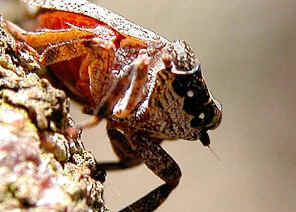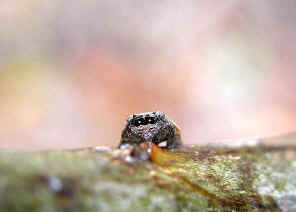|
| |
- We noticed one interesting behaviour of this planthopper. It mimics the
Jumping Spider.
-
- They like to rest on stems of about 10mm diameter. When we came close,
they walked sideway and moved to the opposite side of the stem. This escape
strategy was quite effective on stems of 10mm diameter. The group of
planthoppers disappeared from our eyes in tenths of a seconds.
-
- When we came more closer, they walk forwards or backwards along the stem.
They seldom change their facing direction unless walking backwards and
blocked by something. They jumped and flied away when we touch them by
figures.
-


-
- With more observations, we found that sometimes we confused the
planthopper with the jumping
spider Zenodorus orbiculatus which can also be found on the same
host tree stems. Looked closer to the planthopper, we noticed the eyes
pattern on the planthopper's frons, which made us think it was a jumping
spider.
-


-
- The planthopper may not look like a jumping spider in the human point of
view. Imagine if you were an ant or a jumping spider walking along the 10mm
thick stem. When you met the planthopper, most likely you will see the
planthopper face to face. At this angle, the planthopper looks like a
jumping spider.
-
- This also explained why the planthopper only move sideway, forwards and
backwards but seldom turn around. For if it turns, the mimicking will fail.
-
- The jumping-spider-mimicking may help the planthopper to avoid some
predators, such as ants and even the jumping spiders. We did see the Zenodorus
orbiculatus prey on ant.
-
- Together with our observations on another
planthopper Platybrachys vidua, its backwards movement and
eyes-pattern on wing tips to mimic larger animal. We speculate the
planthoppers adapted the backward movement first, and then eyes-pattern on
frons and on wing tips individually in evolution later.
-
- We have more discussions in our Mimicry
and Camouflage pages.
[ Up ] [ Warnings ] [ Ants Mimicry ] [ Wasps Mimicry ] [ Black Wasps Mimicry ] [ Bees Mimicry ] [ Lycid Mimicry ] [ Jumping Spider Mimicry ] [ Self Mimicry ] [ Bird-dropping Mimicking ] [ Behaviour Mimicry ] [ Threaten Sign ] [ Mimicry in Butterfly ] [ Camouflage Master ] [ Eyes Pattern ]
|




